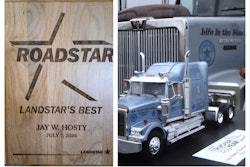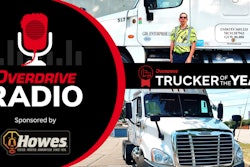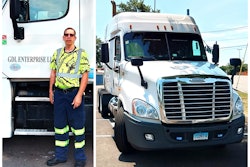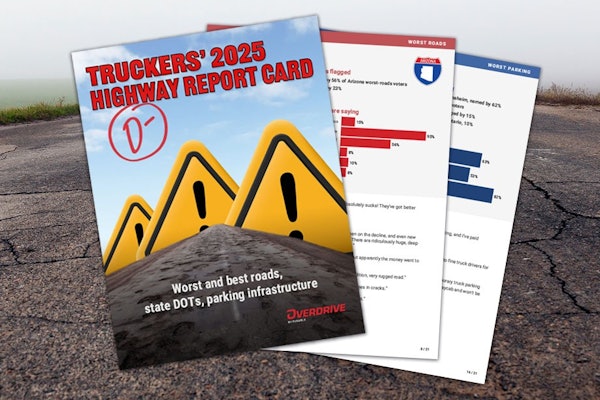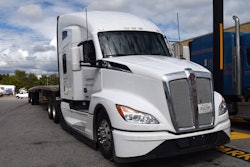"Some guys customize their truck via paint, chrome, lights, and things like that. I customize my truck to make it a more comfortable place to be, a more profitable truck, a more efficient truck." --Owner-operator Alan Kitzhaber
Updated September 2, 2024: It's another rewinder of sorts for this week in the Overdrive Radio podcast series. If you missed the news last week Tuesday, owner-operator Alan Kitzhaber out of Eau Claire, Wisconsin, was honored as our August Trucker of the Month, putting him in the running for Overdrive’s Trucker of the Year award with his three-plus decades trucking and 4 million miles logged behind the wheel of his long-running 1995 Kenworth T600.
Listeners have heard Kitzhaber in recent memory, of course, when he passed the 4-million-mile mark on the T600’s odometer in May we aired this talk originally in July. For those who missed the talk, this week hear Kitzhaber on his approach to keeping that rig running right these past decades and so many miles.
Original story with the podcast follows:
May 2024 was a big month for owner-operator Alan Kitzhaber, running as Oakridge Transport out of a home base in Eau Claire, Wisconsin, now with authority for getting on a decade and a half. That month, he celebrated with family the graduation of one of his brothers with a Master’s degree in counseling, that brother’s son’s completion of a PhD in chemistry, and graduation of the brother’s daughter from high school.

Owner-operator Kitzhaber himself, treated for prostate cancer earlier in the year, was celebrating an undetectable blood test marking his freedom from that condition. He crafted a light blue ribbon in the icing on a brownie cake he made as they all got together at his brother’s house to celebrate.
Just what else Kitzhaber put on that cake, as you can see below, was yet another reason to celebrate.
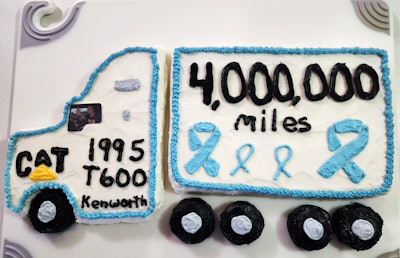 Also in May owner-operator Kitzhaber passed the 4-million-mile mark in his 1995 Kenworth T600.All photos courtesy of Alan Kitzhaber
Also in May owner-operator Kitzhaber passed the 4-million-mile mark in his 1995 Kenworth T600.All photos courtesy of Alan Kitzhaber
He crossed the 4-million-mile mark in the Caterpillar 3406E-powered 1995 T600, every one of the miles logged under his expert piloting.
With all those safe miles in the rear view in just a single truck, Kitzhaber joins a pretty exclusive club. I know of one other owner Overdrive readers have heard from who's done similar -- "Mustang" Mike Crawford crossed 4 million in his 1994 Freightliner (12.7 Detroit-powered) back in 2022. (Incidentally, I spoke with Crawford July 1 as he hit the Prime yard in Springfield at the end of his final run before retirement with a grand total of 4,159,910 miles in the rear view of the Freightliner. More on Crawford’s final run in a future podcast.)
[Related: One man, one truck, one rebuild, one grainy photo mark 4 million safe miles in the rear view]
 Kitzhaber today hauls for the Menards company as his primary customer, utilizing vans and the occasional reefer during the winter months, likewise specialty trailers like the one pictured here.
Kitzhaber today hauls for the Menards company as his primary customer, utilizing vans and the occasional reefer during the winter months, likewise specialty trailers like the one pictured here.
In this week's edition of Overdrive Radio, track back through some of owner-operator Alan Kitzhaber’s career, which stretches back to 1990, his time as owner-operator some years on with Millis Transfer. It was there he first took the reins of the then-brand-new 1995 KW as a company driver. He bought the truck from the company itself, then, a few years later. Since then, he's been laser-focused on turning that truck into a profit-making machine, and meticulous with record-keeping in no small way.
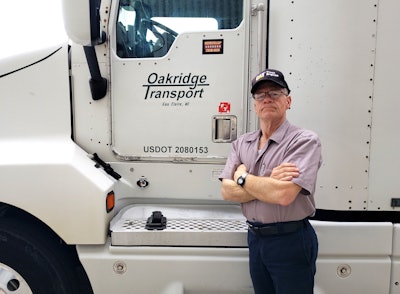 Owner-operator Alan Kitzhaber
Owner-operator Alan Kitzhaber
And 4 million miles is a very long way, to be sure. More than 8 times to the moon and back. At roughly 60 miles per hour it’d take you well past the hard end of the 14-hour clock to do it at roughly 66,666 hours. We track back through the rig's history in his operation a good deal more quickly than that on the podcast, along the way learning plenty about just how the owner-operator kept that Cat-powered T600 humming efficiently for so very long. Take a listen:
As mentioned in the podcast, Caterpillar's interview with Kitzhaber for its Million Mile Club when he crossed 3 million miles you can find at this link.
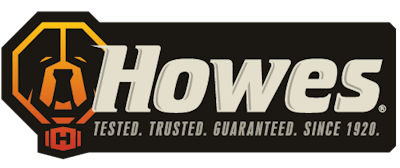 Here's a big thanks to continued support for Overdrive Radio from the fine folks at sponsoring company Howes, longtime provider of fuel treatments like its Howes Diesel Treat anti-gel and Lifeline rescue treatment to get you through the coldest temps, likewise its all-weather Diesel Defender and Howes Multipurpose penetrating oil, among other products.
Here's a big thanks to continued support for Overdrive Radio from the fine folks at sponsoring company Howes, longtime provider of fuel treatments like its Howes Diesel Treat anti-gel and Lifeline rescue treatment to get you through the coldest temps, likewise its all-weather Diesel Defender and Howes Multipurpose penetrating oil, among other products.
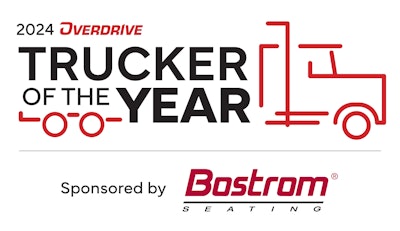 We’re at the final sprint for the Trucker of the Year award program for 2024. Nominations will close at the end of September, and we’ve got just two semi-finalist slots left for a chance to win a brand-new seat, up to a $2,500 value, from Trucker of the Year award sponsor Bostrom Seating, a trip to and recognition at the Mid-America Trucking Show, various other prizes, and more. Put your own or another deserving business (up to three trucks) in the running via this link today.
We’re at the final sprint for the Trucker of the Year award program for 2024. Nominations will close at the end of September, and we’ve got just two semi-finalist slots left for a chance to win a brand-new seat, up to a $2,500 value, from Trucker of the Year award sponsor Bostrom Seating, a trip to and recognition at the Mid-America Trucking Show, various other prizes, and more. Put your own or another deserving business (up to three trucks) in the running via this link today.
[Related: Odyssey past 10 mpg for max efficiency, in more ways than one]
Find more advice on a myriad of owner-operator business topics, including how to increase efficiency and design a PM program, in the 2024 edition of the Overdrive/ATBS coproduction of the "Partners in Business" book. Download it here. It's sponsored for 2024 by Rush Truck Centers, the premier solutions provider to the commercial vehicle industry with 150-plus full-service dealership locations in the United States and Canada.
Todd Dills: Hey everybody, Todd Dills here, back with another rewinder of sorts for this week in the Overdrive Radio podcast series for this Labor Day, September 2, 2024. If you missed the news last week Tuesday. Owner-operator Alan Kitzhaber out of Eau Claire, Wisconsin, was honored as our August Trucker of the Month, putting him in the running for Overdrive’s Trucker of the Year award with his three-plus decades trucking and 4 million miles logged behind the wheel of his long-running 1995 Kenworth T600. Listeners have heard Kitzhaber in recent memory, of course, when he passed the 4 million mile mark on the T600’s odometer in May we aired this talk originally just a couple months back in July, but for those who missed the talk, here’s Kitzhaber on his approach to keeping that rig running right these past decades and oh so many miles.
And: we’re at the final sprint for the Trucker of the Year award program for 2024. Nominations will close at the end of the month and we’ve got just two semi-finalist slots left for a chance to win a brand-new seat, up to a 2500 dollar value, from Trucker of the Year award sponsor Bostrom Seating, a trip to and recognition at the Mid-America Trucking Show, various other prizes, and more. If you or another deserving owner want to put your business in the running, visit OverdriveOnline.com/toptrucker to do that. We’d really appreciate the opportunity to learn and share more about the business. That’s OverdriveOnline.com/TopTrucker. Now, here’s our original talk with Kitzhaber, which as noted aired originally July 15. Congrats again to Alan Kitzhaber, Overdrive’s Trucker of the Month for August. Here we go.
Todd Dills: May was quite the month for owner operator Alan Kitzhaber, running with his authority out of a home base in Eau Claire, Wisconsin. Now, for getting on a decade and a half as Oakridge Transport. That month he celebrated with family the graduation of one of his brothers with a master's degree in counseling. That brother's son, then, with the completion of a PhD in chemistry and the graduation of the brother's daughter from high school. Owner-operator Kitzhaber himself, treated for prostate cancer earlier in the year, was celebrating an undetectable blood test marking his freedom from that condition. He put a light blue ribbon in the icing on a brownie cake he made as they all got together at his brother's house to celebrate.
I'm Todd Dills, and just what else Kitzhaber put on that cake. What you can see in the cover image for this Overdrive Radio edition is the reason we're here talking to Alan today.
Also in May, Alan Kitzhaber completed a remarkable feat in his 1995 Kenworth T600 Cat 3406 E powered. He crossed the 4 million mile mark in that single truck alone, every one of the miles logged under his expert piloting. I only know one other owner to have done that. You all have heard him on the podcast before, of course. It's the Mustang Mike Crawford, who called me July 1 as he was hitting the Prime yard in Springfield at the end of his final run before retirement, with a grand total of, 4,159,910 miles in the rear view of a 1994 Freightliner powered by a twelve seven Detroit. More on Crawford's final run in a future podcast. Be sure of that. You'll find a story marking his passing the 4 million milestone from 2022, linked in the show notes for this podcast and in the post that will house it when it goes live, July 15 at overdriveonline.com. overdrive radio owner operator Alan Kitzhaber's career stretches back to 1990, his time as an owner operator some years on with Millis Transfer, where he first took the reins of the 1995 T600 as a company driver that year. He then bought the truck from the company itself a few years later from the current CEO, Dave Millis. In fact, Kitzhaber said.
Alan Kitzhaber: He’s the one that sold the truck to me. Whether he remembers it or not, I don't know. I have the bill of sale. I have all my records from date I became an owner-operator.
Todd Dills: Yes, he's been meticulous with record keeping in no small way through the years since. Likewise with modifications to the truck, all aimed at improving business performance and in cab comfort.
Alan Kitzhaber: You know, some guys customize their truck via paint, chrome, lights and things like that. I customize my truck to make it a more comfortable place to be a more profitable truck, more efficient truck.
Todd Dills: There's a whole lot to those modifications he's made for certain detailed in today's episode. 4 million miles is a very long way. How many times did the moon in back? If you could drive there, what would you guess? The answer turns out to be more than eight times. And at roughly 60 mph, it'd take you well past the hard end of the 14-hour clock to do it. 66,666 hours. We'll track back through Kitzhaber's history a little more quickly than that today on the podcast. Of course, along the way, learning plenty about just how the owner operator kept that Cat powered T600 humming efficiently for so very long. We'll do all that after this quick break, so keep tuned.
Speaker 3: Keep your rig running right year round with Howe's Diesel Defender. It provides maximum lubricity to protect your entire system and contains specialized IDX four detergent to clean and prevent deposits. It safely removes harmful water and guarantees a 5% increase in fuel economy or more. Diesel Defender, now available at your local O’Reilly Auto Parts store. You can also grab a bottle at truck stops nationwide or have it delivered when you shop the Howes store on Amazon. Defend your diesel with Howes.
Todd Dills: You can find plenty more information about all of Howes’ formulations at HOWES, Howesproducts.com.
Here's Alan Kitzhaber setting up his history of trucking.
Alan Kitzhaber: Originally, I'm from Greenwood, Wisconsin, which is about 50 miles to the east. I grew up there on a dairy farm. I've been in Eau Claire since 1990. That's when I started trucking. I started, I went to trucking school in January of 91 and then started, trucking for pay in March.
Todd Dills: You were a company driver to start.
Alan Kitzhaber: I started out as a company driver, yeah. And I did that for seven years, until 1998. And then, I got into this truck brand new. When it was in 1995, January of 1995. And then, in August of 98, I bought it from. At that time it was Millis transfer out of Black River Falls. At that time, they were promoting, handing their fleet with owner operators and selling trucks to them. And they eventually got away from that. I guess, I'm not sure all of the reasons why this wasn't working out for him or what the deal was, but, as years went by, there seemed to be fewer owner operators. My lease ended there in 2009 and I leased on with a company called Transport Designs out of Savage, Minnesota. I was there for a year and a half and then I got my own operating authority. And then I contract with Menard’s in Eau Claire, Wisconsin. And I make deliveries to their stores, their distribution centers, and pick up from their vendors. I had one other stop in between there, 2002 I leased on with United, van lines, did that for one summer. And that was enough to realize that that just wasn't my cup of tea. I went back to working, as a lease owner operator for Millis transfer at that point.
Todd Dills: You passed 4 million mile mark in this truck yourself. but it wasn't all under your ownership at the very start, right? But you were in it from the get go, it sounds like, at Millis as a company driver.
Alan Kitzhaber: Yeah, I was, I was in it at the get go. And dispatcher I had when I got into that truck. And when I started working for Millis transfer is still employed there. I just talked to him about a month, three weeks ago, maybe a month ago, something like that. And he told me he was going to retire in July.
Todd Dills: When you bought this truck, I can't imagine that it was in your head that that you would get to 4 million miles and still be hauling with it, with the same engine and everything. So how did you do that?
Alan Kitzhaber: Well, when I bought the truck, I figured once I had it paid for, I'd be just like any other driver and just buy a new truck or a newer one. But the .com bubble hit and the economy kind of went into the toilet. And I also had thoughts of getting out of trucking. And actually because I had a background in sales, I was a Radio Shack store manager for nine years. And I got into trucking thinking I would just do it for a couple of years just to see the country and then I would get a real job. And that was 34 years ago.
In any case, I just didn't feel comfortable with the large payments that a new truck would bring me. And so I just figured, well, I'll keep driving it for a while and just see what happens with the economy and hopefully things will improve. And then the government introduced these emissions mandates for 2004, 2007 and 2010. All you heard was nothing but bad from mechanics and other people that were buying these trucks. You know, the problems they were having. I'm going, well, maybe let's just stick with the truck I've got and work the bugs out of this stuff. And that story really hasn't changed at all.
As time went on, it just got worse and worse. And I've got relatives that are in the trucking business. three cousins or four cousins at one time were employed by Reem Kenworth. And they all said, just, you know, hang on to the truck you got. Every mechanic I talked to said, just keep the truck. You got. You got a good one. Don't screw around with these new ones because of the problems they have with all the emissions and so forth. And I decided that, why not? Let's just do that. I'll just keep driving it as long as I can. Hopefully it'll last until I retiree. And, then I got to 3 million mile mark, and I, interviewed with one, of the representatives from Caterpillar, because Caterpillar has a million miler club.
Todd Dills: Quite a time ago now, that 3 million mile mark. You can find that brief interview on the Caterpillar website. I'll post a link to it in the show notes wherever you're listening, and in the post that will house this Overdrive radio podcast for July 15, 2024, at overdriveonline.com/overdrive-radio.
Alan Kitzhaber: I told them at that time that, go for 4 million because it's right about the time that I planned on retiring was about the time I'd hit 4 million. Actually, I wanted to retire a little bit earlier than that, but when you get that dog on close, you just kind of say that. I just decided to stick with it for another year or so to get to that point.
Todd Dills: Give me the full rundown of the specs of this Kenworth T600, and let's just go through a little bit of the mechanical history on it and what you've done to it through the years and the kind of the approach you've taken to preventive maintenance and everything. it's a 1995 Kenworth T 600.
Alan Kitzhaber: Got a Caterpillar 3406 e engine in it. And originally, the truck was a 375 multi torque engine. And when I was in West Virginia, 2001, I believe 2000 or 2001 had an injector tip break off and got caught between the valve and the valve seat, which caused the valve to bend, which caused the valve guide to break. And you could, you could hear when I was driving here this ting ting ting plunk as it went through the turbo. And so I'm sitting on the side of the road and got towed to an International dealership, which was a Cat authorized facility as well and, the cost to repair it at that time was only, like, 1,000 or 2,000 less than it was just to overhaul it. And Caterpillar had something called pick your power program at that time, and you could overhaul it as a low horsepower, mid horsepower, or high horsepower. And, of course, it's always better having more horsepower. So I went with the high horsepower option. I was also due at that particular time with 750,000 miles on it. I was due to put in new bearings and injectors, and so I looked at the cost of doing all of that, and it just was a no brainer, just overhaul it. And, so I re rated it, to the high horsepower rating. But when you did the high horsepower rating, you could go between 475 and 550 horse. And because the transmission in the truck at that time was rated at 1450 torque, upgrading it to 475 torque or the 550, the torque rating would be much higher than what the transmission was rated at. So, originally, I rated it at 475 and just took it easy going down the road. And that lasted for about a year or two until the transmission started getting a little bit loose. And, it had about a million miles on it. So it wasn't like I, really damaged the transmission with that extra horsepower, at least not too much, anyway. So then I upgraded to a higher torque transmission and then re rated the engine to 550, and that's where it's been ever since. So probably was around 2003 that I did that. The transmission has been overhauled once since then by the shop that I get my truck work done. I got more than 2.1 million on that overhaul so far. The transmission is still. You'd never know it still tight. That's changing the oil every 500,000 miles with synthetic oil. Well, engine oil, transmission, rear ends, everything's synthetic. Well, every 500,000 on the transmission and rear end. The engine is every 50,000. As far as overhauls go, I did an overhaul at. I did build one at 750, and I did want it 2.4 million. The next one was 3.6 million. I got almost 1.7 million out of that first overhaul. And what happened there is I had an injector or not an injector. A liner seal failed, and I took it to the Caterpillar shop. We got to tear it all apart in order to get to that. And the mechanic says there's still cross hatching left on the cylinders, and the bearings, they don't look that bad. You know, you could put new rings and bearings, and just keep going.
I said, no, we'll just overhaul it because you get a warranty. If you do that, then at 3.6 million, I had a head gasket go. And again, you're in a situation where you tear it all down, all the labor and stuff, and they put it all together. Well, you don't have a warranty after they get all that done. You've spent a lot of money. So I guess we'll just overhaul it. The engine itself, mechanically, was great. Still had cross hatchings in the cylinders. The bearings look good. Injectors were good.
I did replace the injectors one time because I had one that was starting to tick on me. And rather than just replace the one injector, I just put a whole fix in.
But as far as other things that I've done to the truck over the years, to try and make it, some guys customize their truck via paint, chrome, lights and things like that. I customize my truck to make it more comfortable place to be a more profitable truck, more efficient truck. And in doing so, some of the things I did is put an APU on it for air conditioning. And you have an alternator on there, so that helps charge the batteries overnight, heat them up.
Todd Dills: Diesel fired APU?
Alan Kitzhaber: Tripac APU. But I have a Pro Heat on there, too, which heats my coolant and heats the engine, as well as keeping the cab warm during the winter. The other thing that I put on there is I have an Arctic Fox inline fuel heater, which heats the fuel prior to getting to the engine. And since I put that on, I haven't used any kind of diesel fuel treatment. And that's. So that's been 13-14 years that's been on there that I haven't. I mean, you can take the lid off the fuel tank, and you look in there and you can see that the fuel's gelled up, but yet the truck starts and runs great because it heats up that fuel prior to getting it to the engine. That's huge in the wintertime. And the other thing I have, too, is an auxiliary fuel tank that is used for the Proheat and the Tripac. They get their fuel from that separate tank. there is a tax advantage doing that because you're not using that fuel for running down the road. There's a tax credit that your accountant can give you at the end of the year. It's not huge, but it helps add up. But the advantage of doing that is I can stick fuel at tank that is like a number one diesel or premium diesel or some highly treated diesel. That's not going to gel up on me, that I know that those two, those two units I can get going.
If I can get those two units going, then the truck can go. That was really important. It's a small tank. It's, ah, 14 gallons is all it is. That's very, very helpful.
I also have something called a fuel preparator, which I don't know if you're familiar with those or not. It's a little bit like the FASS System.
Air dog bought them out. Originally it was a Fuel Preparator. Air dog bought them out. So that's the name that you see on them now. But I put one of those on 15 years ago or so, and that just helps take the air out of the fuel. And, I also have OPS’s oil filtration system on the truck. And, I change those filters every 25,000 miles is what they recommend. It's a ten-inch filter that I'm using on it. And I changed the oil on the engine because I'm using synthetic oil as well as using a bypass filter. I change the oil every 50,000 miles, and I've done that since the truck was new. Originally, the truck had a spinner oil filter, bypass oil filtration system on it. And that ended up just started, making a bunch of noise on me, vibrating. And so I didn't know if it was failing or what it was, so I just changed it up. And that's been working just fine since.
Another thing I have on there is a Groeneveld automatic greaser that's been on there since the truck was brand-new. You go to their website, they have all kinds of greasers, but I've had that on there. And the longevity that you get from those greasable components is much greater with that automatic greaser on there than someone who grease their truck even every single month, every 15,000 miles or whatever they choose to do. I mean, there are some guys out there, they probably grease the truck once a week, and if they are, then they're doing real good. It probably pays off. But I don't know of anybody that does that every week. But this gets greased constantly.
Todd Dills: Longtime owner operator Gordon Alkire long swore by what he called a closed greasing system, one he built himself and shared the details of with Overdrive years back. It's not automatic per se, yet solves the issue of needing to get up under the truck to do the work increasing. Find a link to that story from way back in 2012 in the July 15 post housing this podcast when it goes live at overdriveonline.com.
Alan Kitzhaber: Pressure pro higher tire pressure monitoring system, that I've had in there for a long, long time. It was back in the day when Flying J used to have, they still do have point card thing through Pilot, but they used to have a little catalog where you'd order stuff after you got a certain number of points. I got up to where I had a lot of points saved up. I didn't use. I used that to buy a pressure pro with that on the truck. That's, you know, for the guys that are listening. When that changed over from a catalog system to a point system, I don't know when that was. It's been a long time. That Pressure Pro has been on the truck for probably 15 years or, 15, maybe 20 years. I've been under 20 years.
I have a power inverter in the truck with a microwave and a tv player, dvd player, just for creature comfort kind of things. I have a dashcam in the truck that saved my butt a couple of times, and a couple of hit and runs. One was a hit and run, the other one was an attempted hit and run until they realized that I could drive as fast as they could.
Another thing I did in the truck, one of the first things I did to the truck is I put, I'm sure you've seen these vents that rvs have in them vents, and many of them have fans in them. That's one of the first things I did was put that in my truck in sleeper area, and then you can buy these screens to put in your windows. Breezeway, I think maybe was the name of the company that sold them. I don't know if they still sell them or not, but you put that in and turn the fan on, you can draw some air through the truck, which is really makes it a lot more comfortable, especially in the spring and the fall when the temperatures aren't extreme in one direction or the other. And that was just another attempt for me to try and economical and cut down on my idle time is increase my comfort in the vehicle.
Todd Dills: As long as you're not parked next to an idling reefer, sucking all that diesel fuel in there, diesel exhaust into your cab, right.
Alan Kitzhaber: That's one of the downsides to that system is years ago there was a lot more idling, but now there's not near as much idling anymore. And because of that, because the idling is reduced, you know, you don't have that problem as much as you used to. That used to be a problem, or there was times when I couldn't even use it.
I think it was 2011, or twelve. One of the two is I went from having a twin drive, or twin screw driver, whatever you want to call it, dual drive axle truck, to a single drive axle truck with a tag axle. The two big things that, that gained me fuel economy of about four to five tenths of a mile to the gallon. And it I also, at the same time, I took off the eight steel rims and put on four super single tires with aluminum rims. The combination of these two things reduced the truck weight by 1200, which was huge. Fuel economy over the last ten years running average is 6.93. Last five years. It's not that high.
I had a couple of years in there would have been in, 2013 and 2014, where I got this bug to drive 57 miles an hour all the time. 58 miles an hour, something like that, just to see what I get for fuel economy. And in 2013, I got 8.04, and in 2014 I got seven, 7.86. And, it depends a little bit on the trailers you're pulling. And I was playing flatbeds, vans, different kind of trailers that, were not necessarily aerodynamic. I could have pulled just dry vans all the time. At that speed, I'd have been over 8 miles to the gallon constantly. But over the last, say, five years, I can go right down the list for the last five years here. 6.67 6.67 6…
Todd Dills: Yeah, pretty consistent.
Alan Kitzhaber: I pull reefers in the wintertime a little bit when they have freezable stuff, at least reefers during those winter months. So I'll pull them just a little bit. Otherwise, I pull dry vans and I pull flatbeds. And they have some specialty trailers. I don't pull all of their specialty trailers. They have some specialty trailers that are for delivering, trusses to job sites. And I don't make job-site delivery, so that's why I don't pull those. But I do pull another trailer, which I think you saw. One of the pictures I sent you has a picture of that, but it doesn't have. It has pallets on the trailer instead of the finished product. It's a triple decker trailer, and it is much like pulling a car hauler trailer. It's just not very aerodynamic. You get hurt quite a bit as far as fuel economy. And actually, I pull those quite often. I do those probably close to 50% of the time.
Todd Dills: That could be the reason for your, one of the reasons, anyway, for your, 6.67 miles to the gallon these days, rather than eight.
Alan Kitzhaber: Yeah, well, it has a lot to do with it. And the other thing is, I'm driving a little faster now than I was then, just because. Matter of efficiency. As far as you know, if you drive slower, you can't get the load delivered. You have to wait till the next day to get delivered. It all depends. You have to make that. You have to do the math on it and figure out what works best.
Todd Dills: And there's a lot that you've done, and it all adds up to a big picture. I'm just wondering what your thought would be. If there's any. If there's any one thing that you did that you feel like kind, of led to this, to this particular milestone. what do you think had the biggest impact on the longevity of this truck?
Alan Kitzhaber: Maintenance program. Just plain and simple, your maintenance program, because you are not going to run a truck. There's trucks out there that are three years old that are probably worse condition than my truck is just because guys don't take care of it. But the key is, if you want to run a truck long term, number one, number one, big number one. Something's broke, something needs to be fixed, fix it now. You don't wait. Things just add up, and pretty soon you got yourself a pile of junk with a huge bill, and you go, I don't want to do it. I'll just trade it in and buy a new truck.
Todd Dills: Kitzhaber's approach to maintenance, if you haven't gathered, is of the proactive variety, to say the least.
Alan Kitzhaber: I can't tell you the number of times that they found little things here or there that, if I hadn't done this, would have left me sitting on the side of the road or sitting in a PlayStation someplace, having had road service come out and work on my truck.
Todd Dills: In a future edition of Overdrive Radio, we'll hear more about his longtime go-to maintenance partner there in the area around Eau Claire, Wisconsin, home base for Oakridge Transport, operating with authority, pulling for that solid customer in menards now for many years, they've no doubt got a steady hand in Allen Kitzhaber. Here's a big congrats to him for hitting that 4 million mile mark in the 1995 Kenworth T 600, customized with efficiency in mind and with the right maintenance plan for its longevity. We’re looking forward to more from the owner operator, so keep tuned. Find some further pictures of the rig in the post that will house this podcast live at the world famous overdriveonline.com July 15. Thats overdriveonline.com/Overdrive-Radio. Big thanks for listening wherever you find the podcast.





